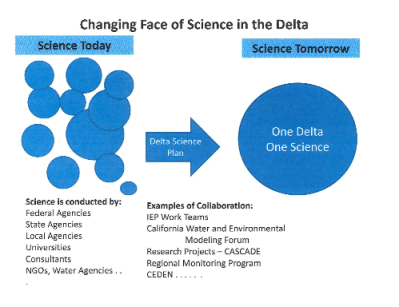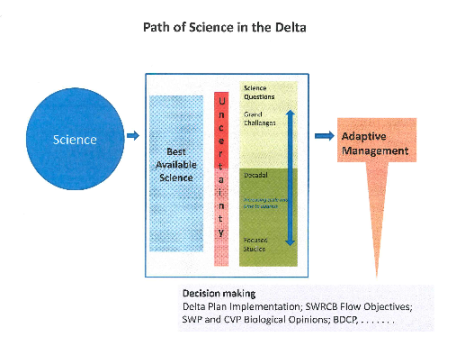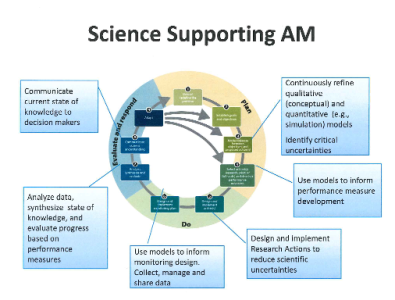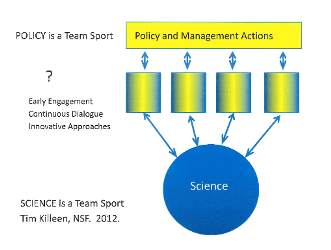
With the Delta Plan calling for a comprehensive Delta Science Plan to be in place by December of 2013, development of the Plan is a high priority for the Delta Stewardship Council and the Delta Science Program. How can the best available science and adaptive management be incorporated into the policy decisions? And what about those scientific monks? These were topics of discussion at the November 15th Delta Stewardship Council meeting. (This is the second of two-part coverage from the meeting; click here for part one.)
BEST AVAILABLE SCIENCE AND THE DELTA SCIENCE PLAN
With science destined to play a major role in the Delta going forward, developing the Delta Science Plan is the science-policy interface and the number one priority for the Delta Science Program, began Lead Scientist Dr. Peter Goodwin in his presentation to the Council.
The mandates for the increased role for science are clear and explicit. At the joint press conference in July, Governor Brown and Secretary Salazar stressed the importance of science in solving California’s water problems, saying: “Science will guide how best to restore the ecosystem and how much water can be exported.” The Delta Reform Act and the Delta Plan both call for an increased role for science, mandating that the coequal goals must be achieved through best available science and adaptive management, with ‘best available science’ being required for covered actions and adaptive management being required for ecosystem restoration and water management, as specified in the Delta Plan’s policy GP1. Additionally, adaptive management and best available science has to be used for updates to the Delta Plan, so the science plan needs to consider all of that, said Dr. Goodwin.
‘Best available science’ is defined by the Delta Plan as being the knowledge base for making sound decisions, and it is specific to the decision being made as well as the time frame available for making that decision. Best available science is developed through a process that meets the criteria of relevance, inclusiveness, objectivity, transparency, timeliness, peer review, and is consistent with the scientific process. This definition is important, Dr. Goodwin explained, because it will be foundation for adaptive management decisions which will often be controversial; these decisions will have to be able to withstand close scrutiny, both legally and scientifically. The Science Plan itself needs to put all the elements in place for a defensible form of best available science, he said.
NAILING DOWN THE SPECIFICS OF THE PLAN
So what will the science plan actually do? There are multiple science programs and multiple research activities currently underway in the Delta, said Dr. Goodwin; most is very good science, but a lot of science is focused on single issues, some of the programs are mandated by law, and some is fundamental research being conducted in academia.  There are federal, state, NGOs, and water agencies at work, and the federal and state agencies have their research centers, science centers, and research programs. The challenge is how to pull all of that information and programs together to create a single foundational science that we all work from, said Dr. Goodwin: “It’s not that people don’t wish to collaborate, it’s just that this is such a complex and fast moving landscape.”
There are federal, state, NGOs, and water agencies at work, and the federal and state agencies have their research centers, science centers, and research programs. The challenge is how to pull all of that information and programs together to create a single foundational science that we all work from, said Dr. Goodwin: “It’s not that people don’t wish to collaborate, it’s just that this is such a complex and fast moving landscape.”
The Delta Science Plan needs to integrate the science into a common understanding, but Dr. Goodwin pointed out that we’re not starting from scratch; there are already good examples of collaboration underway, such as the California Water and Environmental Modeling Forum. Twenty years ago, the main debate was about whose model was the best; since the creation of the Forum, people aren’t debating which model is better anymore: “The discussion is on the questions, not so much the scientific underpinnings of the model.” Other examples of successful collaboration in the Delta include IEP work teams, funded research projects, and regional monitoring programs.
The Delta Science Plan will pull all of this together and create a common knowledge database, organizing and integrating Delta science to provide both the best available science and support adaptive management. One Delta – One Science, said Dr. Goodwin: “It doesn’t mean everybody agrees one everything, but it identifies what we know, highlights areas where there’s legitimate scientific disagreement, and helps focus resources on those areas of disagreement.”
 The Delta Science Plan will include strategies and approaches for policymaker’s “grand challenges”, institutional and organizational structure for science, synthesis of scientific knowledge, uncertainties and prioritizing research, data management and accessibility, shared computer models, knowledge bank, and recommendations on an integrated monitoring approach, said Dr. Goodwin.
The Delta Science Plan will include strategies and approaches for policymaker’s “grand challenges”, institutional and organizational structure for science, synthesis of scientific knowledge, uncertainties and prioritizing research, data management and accessibility, shared computer models, knowledge bank, and recommendations on an integrated monitoring approach, said Dr. Goodwin.
Dr. Goodwin identified three levels for prioritizing scientific questions: at the top level, there are the really big questions or “grand challenges” which take years to address, there are the decadal studies such as the 10 year study of the pelagic organism decline, and then there are the focused studies with shorter time scales of 2 to 3 years. All of those activities need to feed into the adaptive management process and then to decision making, he said.
ADAPTIVE MANAGEMENT IN THE DELTA
The Delta Reform Act defines adaptive management as “a framework and flexible decision making process for ongoing knowledge acquisition, monitoring and evaluation, leading to continuous improvement in management planning and implementation of a project to achieve specific objectives.” The adaptive management process has three phases: plan/do, evaluate/respond, and revisit assumptions and decisions. Within those three phases, there is a nine-step framework. The science plan needs to be geared towards feeding that framework and making it work, said Dr. Goodwin.
 On the Adaptive Management diagram, the blue boxes are the points in the process where you would need science to give you advice to make decisions, Dr. Goodwin explained. With adaptive management, the problem is defined, goals and objectives are established, and then qualitative and quantitative models are developed to make the connections between the goals and objectives and the actions you’re going to take. You use those same models to inform the performance measures to guide whether you’re successful in your action. There is also communication needed to tell stakeholders the results, and then decisions are made, and then feedback into the process, depending on progress made, he said.
On the Adaptive Management diagram, the blue boxes are the points in the process where you would need science to give you advice to make decisions, Dr. Goodwin explained. With adaptive management, the problem is defined, goals and objectives are established, and then qualitative and quantitative models are developed to make the connections between the goals and objectives and the actions you’re going to take. You use those same models to inform the performance measures to guide whether you’re successful in your action. There is also communication needed to tell stakeholders the results, and then decisions are made, and then feedback into the process, depending on progress made, he said.
“Science is a team sport,” said Dr. Goodwin, quoting Tim Killeen of the National Science Foundation. He then explained: ”“You can’t have single investigator or single agency getting to the answers. If you want to accelerate knowledge discovery, you need vast teams, you need access to data, you need people looking at the same problem from different angles, and that’s how we accelerate knowledge discovery.”
 At the same time, policy is also a team sport, Dr. Goodwin said, and the key question is how do you mix decision makers with the scientists themselves? “The difficulty is that if you’re playing baseball, sometimes perhaps we’re playing cricket.”
At the same time, policy is also a team sport, Dr. Goodwin said, and the key question is how do you mix decision makers with the scientists themselves? “The difficulty is that if you’re playing baseball, sometimes perhaps we’re playing cricket.”
Some of the suggestions received include early engagement with science as well as the need for a continuous dialog. The independent panel report on the BDCP’s proposed adaptive management process suggested finding a polymath, or the scientist that could do everything. Participants at town hall meeting, suggested a standing committee where policy makers and scientists can engage directly, with scientists who would be able to speak for the science community. This is really the place where something innovative can be done, said Dr. Goodwin, but no doubt, it’s a big challenge.
The exchange of information needs to go both ways, said Dr. Goodwin. Information needs to come back to the science community so we can refine and ensure the science is relevant and timely, but at the same time, the communication needs to go back up to all of the policymakers, and if multiple agencies are making decisions, the same recommendations should go across those various agencies.
COUNCIL MEMBER’S DISCUSSION
Council member Randy Fiorini noted that what seems to be missing is early involvement with science: “We’re in the age of adaptive management. It’s touched on but it’s not emphasized enough that scientists, policymakers and responsible agencies need to all be together at step one. I don’t think that can be emphasized enough.” To have an agreement among the appropriate scientists, policymakers, and responsible agencies as to what the problem is and what is going to be done about it, with the science community helping to define the problem early on: ”One thing it will do, it hooks them in, at that point, okay, we’ve defined the problem, we’ve got to help find a solution, we can’t just say well, it requires another study, which is the frustrating part for policymakers.”
Chair Phil Isenberg said it is still lacking in details:“If you can’t with clarity describe the problems of the current scientific practices systems, it’s hard to know what should be in a science plan that will allegedly solve the problem.” For example, if multiple entities are the problem, then what is the solution? If that means less entities, how many less? “This inclusive framework for conducting science means information sharing, cooperation and all of that, all of which is probably required by existing law, and everybody thinks they are doing it to the maximum extent possible, but nobody’s happy, as best I can tell, with the way science is being conducted in the Delta,” Mr. Isenberg said; he likes the concept of “One Science, One Delta, ” but doesn’t see the steps yet that will hopefully lead there: “I think they are organizational steps. It’s structure, organization, dedication of funding, the routing of funding, the requirement of flow of information.”
Mr. Isenberg agrees with Mr. Fiorini that early involvement with the science community is important: “Most system operators would trade the current confusing status quo for a scientific involvement that was early and might provide them some assurance that once they have complied with that structural involvement of meaningful science, that their decision is probably better protected against litigation, political criticism, folks with pitchforks wanting to throw them off the barricades …“ said Mr. Isenberg.
Council member Pat Johnston wondered if we shouldn’t lower expectations, rather than raise them, noting that a lot of scientific expertise is employed by the various stakeholders who utilize the science knowledge they have acquired in order to argue their case about some element of the water system or the environment in the Delta. Maybe Dr. Goodwin’s job is to find the fairest-minded smartest unaffiliated scientists to evaluate the plausibility or accuracy of the representations by different groups that are employing people with scientific knowledge or applied recommendations, said Mr. Johnston: “I despair of the notion that you can round up the scientists, because they’re going to say, “Peter, you’re not the boss of me.” The independence is such an ingrained and valuable feature of scientists that the prospect of having a group of scientists funneling into a process that will respond on demand to the needs of policymakers seems unlikely. On the other hand, there are plenty of people who want stuff. They make their proposals, they utilize scientific information, too, and you and other scientists that you include in this process can then tell everyone to what degree that’s likely to be accurate or wroth following or doesn’t have side effects we wouldn’t that want to pursue. “
Dr. Goodwin responded that the Delta Science Program does that to some extent with the independent review panels, which are very carefully chosen. “These issues are so complex and so diverse, that if we have different entities or interest groups coming with their own pet model, their own data sets, drawing their own conclusions, it’s very difficult to be objective and say ‘this is better than that’.”
AND ABOUT THOSE SCIENTIFIC MONKS …
Continuing the discussion, Council member Pat Johnston gave Peter an example: “Is an earthquake going to wreck the water system and the environment by liquefying a lot of levees in the Delta quickly? There are a lot of reports that say that’s a big risk; then again, there are people in the Delta and their engineers that say, it’s really a low risk. I’d be interested in your ‘monastery of scientific monks‘ looking at it and advising us on the likelihood of one direction or the other being correct and what we should draw from.”
Dr. Goodwin responded that for a specific question like that, absolutely, something like that could be done where you look at the data that both sides are putting forth, and what will come out of it are the uncertainties will then help focus more of the science in the future.
Chair Phil Isenberg wondered if Mr. Johnston’s comment didn’t suggest an institutional approach that could be a science plan alternative. That approach would be to centralize and designate a scientific source arguably independent of being purchased by interest groups and to whom serious substantial or critical questions are assigned and an answer is hopefully received: “There are many agencies involved in science, and you’re never going to get everyone to agree on just one. But, you could extract from each agencies that are signatories to the BDCP that they designate their own Delta BDCP lead scientist, and that body collectively becomes a funnel to which information is given and from which arguably decisions are rendered,” said Mr. Isenberg. How the Governor and Secretary Salazar’s statement that science is going to guide both ecosystem restoration and water exports “seems to me likely only through a consolidation of identified individuals for the governmental agencies that are the sponsors of this activity. … Identifying who within a multiple agency is the most responsible scientific opiner might be the best you can get out of multiple organizations,” he said.
Council member Fiorini said that he was focused on application: “when you actually begin implementing things and doing it differently than how we’ve done it in the past … atmospheric rivers, seismic vulnerabilities, temperature, how close are the smelt to extinction, these are all big questions. We can spend a couple of decades talking about those or wait and see what the outcome is, or we can start doing things now. I think the real value to a science plan is to make it applicable and make it different than what we’ve been doing in the past.”
- Click here to view the webcast of this meeting.
- Click here for the Lead Scientist’s power point.
- Click here for part 1 of coverage from this meeting.

